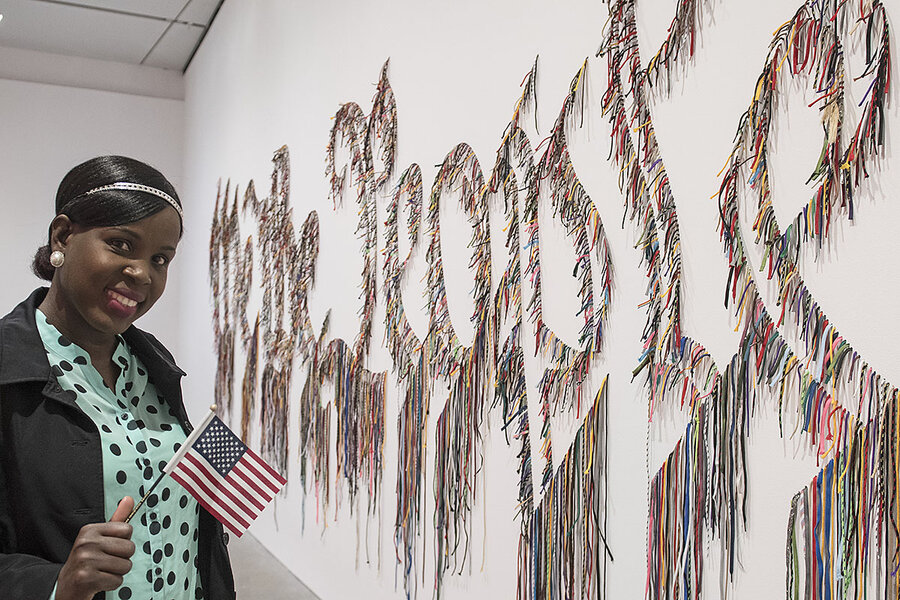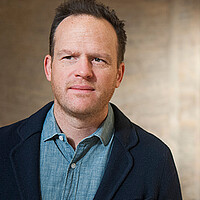How Nari Ward reimagines the immigrant experience through art
Loading...
| Boston
As if the process of becoming a US citizen weren't full of enough symbolism, Andrea Birch-Christian was naturalized inside an art museum.
“It feels good, it feels happy,” Ms. Birch-Christian said after the May 4 ceremony at Boston’s Institute of Contemporary Art. This month, the ICA hosted its first naturalization ceremony, welcoming 137 immigrants from some 50 countries. The ceremony was done in conjunction with a survey of more than 20 years of work by the American visual artist Nari Ward. Like Birch-Christian, Mr. Ward immigrated to the US from Jamaica, in his case as a 12-year-old.
Birch-Christian and few (if any) of the newcomers had ever heard of Ward. They simply showed up at the location assigned by Citizenship and Immigration Services. But the swearing-in was a fitting addition to an exhibit meant to challenge notions of what it means to be American, organizers said.
“Art museums are important civic spaces for us to learn and connect,” museum director Jill Medvedow said during the event, noting that Ward’s work “illustrates what it is like for him to be an immigrant from Jamaica.”
But Ward’s work is more than an expression of his personal journey from Jamaica to New York, where he lives today. At a time when immigration has become a contentious political issue, he’s emerged as one of the most visible artists fostering conversations about the topic in ways that go beyond Republican and Democrat talking points.
Ward’s work “just draws you in,” says Jessica Hong, a curatorial associate at the ICA in Boston. “It’s another invitation to explore these issues.”
To be sure, the museum couldn't have anticipated that the survey would become so relevant to the current political discussion. It originated in Miami in November 2015 and has also shown in Philadelphia. But the messages in his work have taken on new significance under the Trump administration. In another sign of Ward's growing cultural influence, he won this year's Vilcek Prize in Fine Arts. It's a $100,000 award given annually to immigrant artists.
One of the most prominent installations in “Nari Ward: Sun Splashed,” which runs through Sept. 4 in Boston, is “We the people.” The piece spells out the opening words to the preamble of the US Constitution in shoelaces. It’s an arresting image. And it’s an installation that epitomizes Ward’s style of repurposing everyday objects – most of which he culls from New York City streets – to convey powerful cultural and political messages.
But why shoelaces? Why not string or yarn or rope? When Birch-Christian and her husband, Sandy Christian, walked into Ward's show, they recognized images from their native Jamaica – but weren't sure what to make of the laces. Mr. Christian thought they could reference Jamaicans’ penchant for reusing common objects.
Ward’s work is loaded with metaphor and dual meaning. That way, he says, viewers will draw their own conclusions. “I’m trying to find those middle spaces,” says Ward. “There’s always the contrast that creates the conversation.”
For him, the shoelaces served as a visual effect to “We the People” (the phrase is legible from a distance, but becomes more obscure the closer you get) and as a vehicle to make the piece collaborative. Ward sought to create individual connections with the powerful phrase. At other installations of the piece, many of the laces were donated by individuals. In Boston, members of the ICA’s teen group helped assemble the piece; youth groups at other museums have also been involved with its installation.
Today, he lives and works in a former Harlem fire station and much of his art reflects his urban experience. Early in his career, he became known for utilizing found objects such as baby strollers and shopping carts. In 1993, in one of his first major installations, he assembled some 150 discarded strollers inside New York's New Museum for a piece called "Amazing Grace." Since then, his work has appeared in some of the biggest museums and exhibitions around the world.
Figuring out the meaning behind Ward's work can be something of a brain teaser. In one piece called “Iron Heavens,” he uses baseball bats and household oven pans to build an installation that seems eerie and dark. Ward explains he wanted to make a statement about rebirth and transformation by taking the bats – a symbol of the violence in New York City of the 1990s – and turning them into something peaceful by attaching cotton to each one. Another work called “Savior,” also from the 1990s, evokes an elegant figure emerging out of a rusty shopping cart. The body of the figure is constructed of plastic trash bags, fencing, and bottles.
His recent work is less abstract, but no less complicated. His installation at the five-acre Socrates Sculpture Park in Long Island City in Queens is made up of a herd of sculpted goats – an animal that symbolizes sacrifice, hard work, or debauchery. “The goat is a starting point for a conversation around false exuberance,” he says.
The title of the show, “G.O.A.T., again,” references the Greatest Of All Time. Rappers and athletes commonly call themselves “goats.” Still, it’ll be hard to escape the political leanings – it also can be read as a commentary on Mr. Trump’s trademark boastfulness, as well as arrogance in general. The installation includes a neon sign that resembles one from Harlem’s Apollo Theater. On Ward’s sign, however, only the word “poll” is illuminated.
Ward insists he’s not a political artist. “I want to change the way someone may think about their own life,” he says. But he’s also challenging his audiences to see the world around them differently.
Consider the rebar jutting from the backs of his Socrates Sculpture Park goats. In one sense, it’s morbid. But Ward says it’s also an image of optimism, pointing out that many builders in Jamaica and other developing countries leave rebar exposed to make it easier to add more floors. “When I see the rebar sticking out the roof, I always think about it as optimistic possibilities for the next generation.”











